Duxford
| Duxford | |
| Cambridgeshire | |
|---|---|
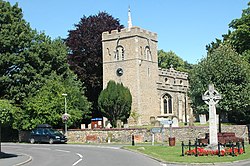
| |
| Location | |
| Grid reference: | TL481461 |
| Location: | 52°5’32"N, -0°9’34"E |
| Data | |
| Population: | 1,836 (2001) |
| Post town: | Cambridge |
| Postcode: | CB22 |
| Dialling code: | 01223 |
| Local Government | |
| Council: | South Cambridgeshire |
| Parliamentary constituency: |
South Cambridgeshire |
Duxford is a village in Cambridgeshire, about 10 miles south of Cambridge.
Originally known as Duxworth and listed as Dukesweorþe in the 10th century, and Dochesuuorde in the Domesday Book the village's name apparently means 'Duc's enclosure', after an otherwise unknown landowner.[1]
History
The village formed on the banks of the River Granta, a little below its emergence from the hills of north Essex. One of the more populous settlements in its hundred it was split into two ecclesiastical parishes in mediæval times until they were united in 1874.[2]
Churches
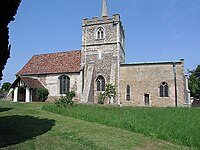
From mediæval times the village was unusual in possessing two parish churches, each with a separate incumbent.
The church of St John the Baptist, as it's been known since at least 1260, consists of a chancel and north chapel, a central tower, and a nave with north aisle and south porch. The chancel, nave, and lower part of the tower were all built in the 12th century, with the tower raised in the 13th century. By the 1860s the building was in disrepair and after the parishes were merged in 1874, the church fell into disuse, and became increasingly dilapidated during the 20th century, despite receiving a new roof and stone floor in the 1960s. Since 1979 it has been run by the Churches Conservation Trust.[2]
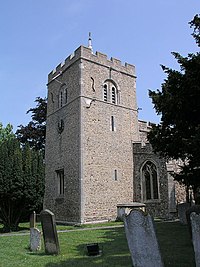
The southerly church has been dedicated to St Peter since at least 1275, and serves as Duxford's present parish church. Built with a chancel, an aisled and clerestoried nave, and a west tower, it too was originally built in the 12th century, and the tower and part of the chancel remain from this period. The nave was rebuilt in the 14th or 15th century. In 1728 the tower had the existing tall spire removed and replaced with the present shorter one. By the time the parishes were merged, the building was also in a poor state, and had to be extensively repaired in the 1880s.[2]
A Congregational chapel was built in the late 18th century and licensed in 1794, and at its peak in 1850 had a weekly congregation of 350. The chapel joined with other Congregational churches in uniting with the Presbyterian Church of England in 1972, and has been known as Duxford United Reformed Church since then.
Duxford Chapel
To the north of the village close to the Royston to Newmarket road lies Duxford Chapel, a 14th-century chantry chapel that was probably part of the Hospital of St John.[3]
Airfield
Duxford gives its name to RAF Duxford, a former Royal Air Force airfield that was used as a sector station during the Battle of Britain. Duxford Aerodrome was the home of Douglas Bader's Big Wing during that battle. Duxford airfield later became a fighter airfield for the United States Army Air Forces operating P47 Thunderbolt aircraft. In 1972 the Ministry of Defence began to house historically important aircraft in the hangars, which became the Imperial War Museum Duxford.
The airfield was used in the film The Battle of Britain. During that production one of the hangars was blown up to simulate a Luftwaffe bombing raid.
Imperial War Museum Duxford
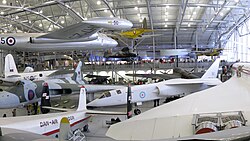
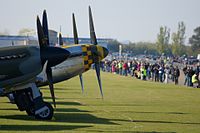
Imperial War Museum Duxford is a branch of the Imperial War Museum, and is built at RAF Duxford, near the village of Duxford. It is Britain's largest aviation museum, Duxford houses the museum's large exhibits, including nearly 200 aircraft, military vehicles, artillery and minor naval vessels in seven main exhibition buildings. The site also provides storage space for the museum's other collections of material such as film, photographs, documents, books and artefacts. The site accommodates several Army regimental museums, including those of the Parachute Regiment (named Airborne Assault) and the Royal Anglian Regiment.
Based on the historic Duxford Aerodrome, the site was originally operated by the Royal Flying Corps and then the Royal Air Force during the First World War. During the Second World War Duxford played a prominent role during the Battle of Britain and was later used by United States Army Air Forces fighter units in support of the daylight bombing of Germany. Duxford remained an active RAF airfield until 1961. After the Ministry of Defence declared the site surplus to requirements in 1969 the Imperial War Museum received permission to use part of the site for storage. The entirety of the site was transferred to the museum in February 1976.
In keeping with the site's history many of Duxford's original buildings, such as hangars used during the Battle of Britain, are still in use. Many of these buildings are of particular architectural or historic significance and over thirty have listed building status,[4] Duxford "retain[ing] the best-preserved technical fabric remaining from [a historic airfield] up to November 1918" and being "remarkably well-preserved". The site also features several purpose-built exhibition buildings, such as the American Air Museum, designed by Sir Norman Foster. The site remains an active airfield and is used by civilian flying companies, and hosts regular air shows. The site is operated in partnership with the council and the Duxford Aviation Society, a charity formed in 1975 to preserve civil aircraft and promote appreciation of British civil aviation history.
Village life
The village has three remaining pubs – the John Barleycorn, the Plough and The Wheatsheaf. Former pubs include The Three Horseshoes, first recorded in 1786, and The King's Head which opened in the mid-19th century.[2]
Outside links
| ("Wikimedia Commons" has material about Duxford) |
References
- ↑ A. D. Mills (2003). "A Dictionary of British Place-Names". http://www.encyclopedia.com/doc/1O40-Duxford.html.
- ↑ 2.0 2.1 2.2 2.3 [1] (Victoria County History)
- ↑ Duxford Chapel
- ↑ Imperial War Museum Duxford (2009) Historic Duxford. Retrieved 15 September 2009.
